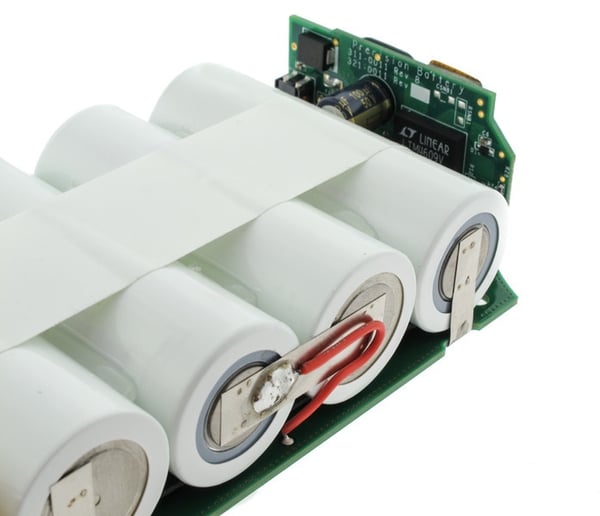When a lithium battery pack is designed using multiple cells in series, it is very important to design the electronic features to continually balance the cell voltages. This is not only for the performance of the battery pack, but also for optimal life cycles.
The use of balancing enables us to design a battery with larger capacity for an application because balancing allows the battery to achieve a higher state of charge (SOC). A lot of companies choose not to use balancing at the start of their custom battery design to reduce cost but without the investment in the cell balancing hardware and software, the design does not allow the SOC to approach 100%.
How Does Cell Imbalance Occur?
If lithium cells are overheated or overcharged, they are prone to accelerated cell degradation. They can catch fire or even explode as a thermal runaway condition can occur if a lithium-ion cell voltage exceeds 4.2V by even a few hundred millivolts.
Every pack that we design and manufacture at Epec has an overvoltage protection circuit (sometime even a backup) to go along with standard balancing that will prevent such an event from ever occurring. In a multi-cell battery pack, which is commonly used in laptop computers and medical equipment, placing cells in series opens up the possibility of cell imbalance, a slower but persistent degradation of the battery.
How are Cells Balanced?
Cell are balanced by the process of equalizing the voltages and state of charge among the cells when they are at a full charge. No two cells are identical. There are always slight differences in the state of charge, self-discharge rate, capacity, impedance, and temperature characteristics. This is true even if the cells are the same model, same manufacturer, and same production lot. Manufacturers will sort cells by similar voltage to match as close as possible, but there are still slight variations in the individual cells impedance, capacity, and self-discharge rate that can eventually lead to a divergence in voltage over time.

Battery Pack Using Cell Balancing
Most typical battery chargers detect full charge by checking whether the voltage of the entire string of cells has reached the voltage regulation point. Individual cell voltages can vary as long as they don’t exceed the limits for overvoltage protection. However, weak cells (ones with lower capacity / higher internal impedance) tend to exhibit higher voltage than the rest of the series cells at full charge termination. These cells are then weakened further by continuous overcharge cycles. The higher voltage of the weaker cells at charge completion causes accelerated capacity degradation. If the maximal recommended charging voltage is exceeded even by as little as 10%, it will cause the degradation rate to increase by 30%.
On the discharge side, the weak cells tend to have lower voltage than the other cells, due to either higher internal resistance, or a faster rate of discharge that results from the lower capacity. This means that if any of the weak cells hits the cell under voltage protection limit while the pack voltage is still sufficient to power the system, the full capacity of the battery will never be used as the pack protector will prevent over discharge (which would damage the cell) by stopping the discharge of the whole pack when one cell voltage goes below the cell under voltage threshold (usually around 2.7V).
Balancing Techniques
The fundamental solution of balancing equalizes the voltage and state of charge among the cells when they are at a fully charged state. Cell balancing is typically categorized in two types:
- Passive
- Active
Passive Cell Balancing
The passive balancing method is somewhat simple and straight forward. Discharge the cells through a dissipative bypass route. This bypass can be either integrated or external to the integrated circuit (IC). Such an approach is favorable in low-cost system application. The fact that 100% of the excess energy from a higher energy cell is dissipated as heat makes the passive method less preferable to use during discharge because of the obvious impact on battery run time.
Active Cell Balancing
Active balancing, which utilizes capacitive or inductive charge shuttling to transfer charge between battery cells, is significantly more efficient because energy is transferred to where it is needed instead of being bled off. Of course, the trade-off for this improved efficiency is the need for additional components at higher cost.
Summary
Balancing cells is not only important for improving the performance and life cycles of the battery, it adds an element of safety to the battery.
One of the emerging technologies for enhancing battery safety and extending battery life is advanced balancing. Since new cell technologies track the amount of balancing needed by individual cells, the usable life of battery packs is increased, and overall battery safety is enhanced.
Key Takeaways
- Cell Balancing Maximizes Performance and Lifespan: Proper cell balancing ensures all cells in a series battery pack maintain equal voltage, which improves performance, extends cycle life, and increases usable capacity.
- Imbalance Leads to Degradation and Safety Risks: Even small voltage differences can cause weak cells to overcharge or over-discharge, accelerating degradation and increasing the risk of thermal runaway in lithium batteries.
- No Two Cells Are Identical: Variations in capacity, impedance, and self-discharge rates exist even among identical cells, making balancing circuits essential to prevent long-term voltage divergence.
- Passive vs. Active Balancing: Passive methods dissipate excess energy as heat and are more cost-effective but less efficient, while active balancing transfers charge between cells for greater efficiency at higher cost.
- Advanced Balancing Enhances Safety: Modern active balancing technologies monitor individual cell behavior in real time, reducing stress on weaker cells, extending pack longevity, and improving overall safety.
















